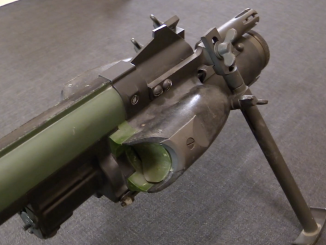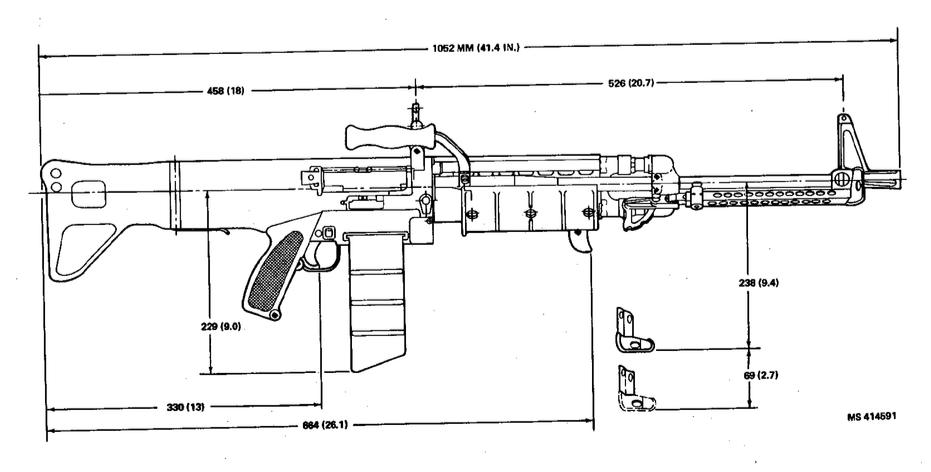In a last hopeful attempt to get a rifle adopted and produced for the US military, John Pedersen designed his own copy of the M1 Garand rifle in the late 1930s (approximately 1939). His toggle-locked rifles had been irreversibly rejected, and the Garand rifle fully adopted by 1936. Pedersen’s exact reasons for making a copy of it are not recorded anywhere I can find, but he did make a number of small changes to the design.
Two series of Pedersen Garand rifles were made, first the GX and second the GY. Only 10-12 of each were ever made, so they are extraordinarily rare today. They all show some detail differences form the M1 in stock design, sight design, etc. However, a persistent question had long been, what differentiated the GX from the GY? When I had the opportunity to examine one of each type side by side, I knew I would have a chance to determine that answer.
The meaningful differences are twofold: clips and gas system. The later GY rifle uses a standard M1 Garand clip, while the earlier GX rifle uses a distinct Pedersen-designed clip. Whether Pedersen was unable to obtain Garand clips to design around or if he thought he could make a better clip is unknown, but by the time the rifles were actually tested in 1943 it must have been clear that if they did not use a standard clip, logistics would immediately rule out their potential adoption.
The gas system difference mirrors a change that the Garand underwent as well. The early GX rifle was originally made as a gas trap style of action, in which the rifled barrel ends just shy of the muzzle, leaving an unrifled and minutely larger bore with a large hole to capture gas pressure just before the bullet exits. This was believed to prevent problems with wear and accuracy caused by drilling a gas port in the barrel itself (the German military also believed this to be a problem, as one can see from their Gewehr 41 development requirements). However, this system instead led to reliability problems, and by 1940 the M1 Garand had been converted to use a normal gas port. The later GY Pedersen had the same change to its manufacture, and the early gas trap GX in this video was retrofitted to that system.




THESE TWO VARIANTS MAYBE ARE GOOD BUT THE JOHN GARAND M1 IS THE BETTER ISSUE.
I’m wondering about the stock? Attempt to save weight? Addition of finger grooves… Sculpting of the pistol grip: reduce tendency of trainee to “drag wood” and have contact with the trigger finger and the stock?
Also: What about those sights? Easier to manufacture or what?
Pedersen’s .276 was the better cartridge, certainly. Garand’s .276 rifle was mighty interesting.
“What about those sights”
I found that John Pedersen has some patent about rear sight:
Patent US1834636 A for Rear sight mechanism for small arms filled 1929
Patent US1834637 A for Rear sight mechanism filled 1929
Patent US2264809 A for Rear sight for semiautomatic guns filled 1939
Latest is closest time-wise to GX and GY rifles, you can see it here:
https://www.google.com/patents/US2264809?dq=ininventor:%22Pedersen+John+D%22&hl=en&sa=X&ved=0ahUKEwjq3rn70dDOAhWC3CwKHWswB-gQ6AEILDAI
if this patent describe sights as seen Pedersen motivation was:
This invention relates to a rear sight for rifles, and has for its general object the production of a precision instrument of this character, the parts of which may be fabricated by usual methods for mass production.
“Pedersen’s .276 was the better cartridge, certainly.”
It was considered that .276 will cause logistic hassle, but anyway .30 Carbine was later added to supply without bigger problems – if .276 would be adopted it is possible that there would be no need for .30 Carbine as .276 would allow crafting lighter carbine than .30-06.
Agreed. I concur. Like all armies in the 1930s, Mgs needed to be long range weapons, so the service rifle cartridge was expected to follow suit:
Italy: 6.5×52 to 7,35×51 FAIL. 8mm Breda.
Japan: 6.5x50SR to 7.7×56… How many 7.7mm cartridges?
Portugal: 6.5mm to 7.92x57mm
Sweden: retain 6.5mm, but adopt huge 8×63 for HMGs and rifles of MG crews.
USA: retain .30-06, but then try to replace pistol and SMGs with carbines, but then keep pistols and SMGs too…
UK: retain dated .303 rimmed cartridge.
etc. etc. Good points.
“Sweden: retain 6.5mm, but adopt huge 8×63 for HMGs and rifles of MG crews.”
Norway also used 6.5×55 cartridge and also crafted special machine gun cartridge – 7.92×61: https://no.wikipedia.org/wiki/7,92_×_61_mm
(14,2g @ 760 m/s)
“UK: retain dated .303 rimmed cartridge.”
Adopted heavy-powder charge version for machine gun (Mark VIII)
“Italy: 6.5×52 to 7,35×51 FAIL. 8mm Breda.”
In fact 8mm Breda preceded 7,35
Nothing really wrong with the 7.35×51mm in principle. It was a reasonably good cartridge for short rifles and carbines without excessive muzzle blast. Ballistics were not great, but adequate up to 400-500 meters. The sights on the Carcano Mod. 1938 short rifle were overly simplified for a rifle cartridge, but that was not the fault of the cartridge.
The US didn’t really try to replace both pistols and SMGs with the M1 carbine. The usefulness of SMGs was not realized yet at the time, so the planned select-fire capability for the carbine was deleted as largely unnecessary complication. Why it took so long to reintroduce it with the M2 is somewhat of a mystery to me, but probably production issues were the cause. In the mean time the Army still needed SMGs, which became clear in the Pacific theater in particular, so simplified versions of the Thompson and finally the M3 Grease Gun were produced.
Officers of course still needed pistols despite the M1 Carbine, and having a pistol as backup weapon was common as well, so there was never question of the carbine completely replacing pistols.
“Nothing really wrong with the 7.35×51mm in principle.”
What advantage it give over older 6.5mm? Was it worth its price of introduction?
@ Daweo:
Likely no advantage was found. 6.5×52 Carcano’s original lethality came from ballistic instability upon impact with the intended victim due to the center of mass being located towards the rear of the projectile. The original rounds had their noses filled with substances less dense than lead in order to cause such instability. While it won’t tear through armor plate very well, 6.5×52 Carcano is more than enough to mess up your innards at ranges exceeding 100 meters! Hiding behind trees won’t save you this time!
The primary reason for the introduction of the 7.35×51mm, according to Italian sources, was to improve terminal ballistics. Apparently, despite rumors to the opposite, the long round nose 6.8mm (actual diameter) bullet was usually quite stable and made a clean hole in living tissue. Another reason was improved external ballistics; the 7.35mm had a higher muzzle velocity even from the 21″ barrel of the short rifle (2480 fps) and slightly better ballistic coefficient (.285 vs .275). The latter reason was considered particularly important for LMGs. The effective range of the Breda Mod. 1930 was limited to about 500 meters by the 520mm barrel and the 6.5×52 cartridge, which gave it a muzzle velocity of only about 2050 fps.
“slightly better ballistic coefficient (.285 vs .275)”
Ok, but if so why they don’t developed better bullet for 6.5mm round?
To be blunt: I don’t know. I have read somewhere that shorter spitzer bullets would not have worked very well with the traditional gain-twist rifled barrels of the M91 Carcano rifles, but not being an internal ballistics expert, I don’t know if there’s any truth to that, or why it would be so.
I noted an additional defining difference to the GX vs. GY version. The operating rod on the GY appears to be lightened just forward of the of the operating handle it has a visual step. This could also be a function of changing from the GAS TRAP SYSTEM to the GAS PORT SYSTEM. It could also be a weight saving feature and also a advantage since the reduced volume of gas in the GY would reduce the forces on the operating rod.
This was a very interesting presentation of the history of the Pederson verses Garand competition.
A question which has often been asked and I cannot find any reference to is the nomenclature of the Garand rifle. The original Garand rifle was the model of 1936. This was the GAS TRAP Rifle. When the GAS TRAP was eliminated the rifle was then called the M1. Were any of the original GAS TRAP rifles marked “Model of 1936”? Otherwise should the GAS PORT Version have been called MODEL M-1A. This is just a personal observation. I would like to hear your thoughts on this question.
I don’t know about the 1936 models, but we did sell “T3E2”, a pre-M1 that was dated Jan. 1931. It is serial #15 and a model designation was not made by year on that particular rifle.
Here is a photo of the markings on that rife: http://www.rockislandauction.com/photos/67/p_standard/BCX306-R-CU82-L.jpg
I don’t know, if this came about earlier or had Garand and Pedersen worked together from the get go, it may have been a pretty neat service rifle.
Maybe get rid of the barrel flutes so they could be cranked out faster or change up the front sights to the one the M1 was rocking while keeping the rear drum, that thing looks sweet and sounded pretty strong when Ian twisted it in the GY vid.
“I don’t know, if this came about earlier or had Garand and Pedersen worked together from the get go, it may have been a pretty neat service rifle.”
It seems that Pedersen has big lack of luck with military weapons in contrast to civilian fire-arms (most notably he designed pump-action rifles for Remington)
Maybe if Garand and Pedersen collaborated they could have achieved something for both military and civilian sales. Pedersen found which gun designs were best for the domestic private sector while Garand had success with military contracts… Did I mess up?
Garand worked tirelessly to get his one rifle into production. That was while the War Department changed its mind about a lot of things. To provide the US Army, and the first army of any real size, with a large scale issue of a new class of rifle, took determination of steel. Almost anyone else would have given up on the project. Probably few people work day after day for years on a project without knowing if it will ever amount to anything. Being at the Springfield Arsenal, Garand contributed to other designs and made some prototypes, some of them interesting, but never followed them all the way to completion as he had for the M1.
Pedersen worked on a lot of projects: pistols, shotguns, military arms, etc. Some of them successful, but mainly he dealt with private arms manufactures. He was not known for making guns that were easy to produce or maintain–clever guns yes, easy to make not really. His redesign here looks like it did take care of an issue of the M1, it did away with the opening behind the operating handle that could let in dust and mud. Probably a real issue, but not one that GI’s were complaining about.
The problem he could have exploited, earlier on, was that the M1 was not that easy to produce. There is a currently significant market for parts for M1s in the US yet some parts (e.g., the op rod and gas cylinder) simply can not be economically reproduced. Whereas more than half a dozen non-arms companies made M1 Carbines, only Springfield Armory and Winchester made M1s during the war. Since it was challenging to make Garand himself designed to tooling to make it. If anyone ever “gave birth” to a rifle surely it was Garand. He forced his way through every obstacle. When Johnson challenged the M1 later on, half of his argument was that and ordinary manufacturing plant could crank out his design given a supply of modified rifle barrels. But it was too little to late–Winchester and Springfield were already producing the M1. Now if Pedersen had brought the concept of design-for-manufacturability to the table in the mid-1930’s he might have prevailed, but Pedersen never seemed to have a good grasp on how to design guns that were easy to make. Just as well, as the Japanese would have copied it if the US Army had adopted an easy to manufacture semi-automatic battle rifle.
“Pedersen never seemed to have a good grasp on how to design guns that were easy to make”
It seems that Pedersen motto was never chose simple way or similar.
“Pedersen found which gun designs were best for the domestic private sector while Garand had success with military contracts… ”
Note that some Pedersen civilian design were later adopted to military purposes – see Remington Model 10 Trench Gun
http://www.historicalfirearms.info/post/144166939260/remington-model-10-trench-gun-while-the-winchester
You have done many videos about Pedersen’s designs, and often mention his desire to get them adopted at least as substitute standard to the M1. Why was it Pedersen was so fanatical almost on getting one of his designs adopted? He was a successful gun designer in his own right, and surely could not have been in it purely for monetary gains? It seems he was almost unable to accept the fact that the M1 Garand was simply better than any of his designs, does anyone have any insight into WHY he just couldn’t let it slide?
Failing to convince the UK to go for his self-loader vs. retention of the M1907 action and “new and improved” easier-to-produce No.4 Mk. I had to hurt a bit, no?
Equally fascinating, John C Garand was always humble and self-deprecating when compared to J. Pedersen… I think his failed Springfield Armory “light rifle” carbine entrant was a tribute to Pedersen in some ways…
On the GX with it’s gas port beyond the rifling and the constricting insert in the gas plug, wouldn’t it be considered a low flow gas trap system?
Perhaps someone, if they have the details of the clip and its dimensions could get some made up and post details online and see if it can be figured out the supposed benefits of it.